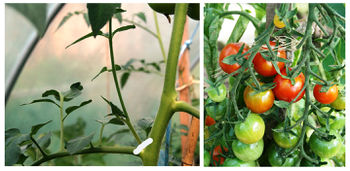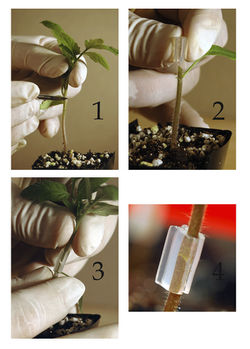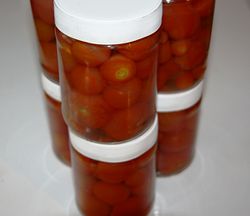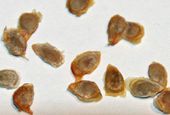Tomato
When your tomatoes don't ripen
Most gardeners know that you have to pinch out the suckers from tomato plants (left photo). Sometimes it is necessary to do more pruning on tomato plants when the fruits ripen. Tomatoes get red quickly in full sunlight but take a long time in the shade, even under hot conditions. They also don't get very sweet without direct sunlight. Tomato fruits first grow lower on the plant, later they appear in the top. When your tomato plant has formed fruits, you can remove the leaves and branches that shade the tomatoes. Tomato plants are fast growers and they can easily do without these leaves.
Tomato grafting
Tomato grafting is done by growing an upper part of a tomato species on a rootstock of another tomato species. The rootstock is chosen for vigorous growth of the roots and resistance against soilborne pathogens. The upper part is chosen for good fruit characteristics.
Grafting of vegetables began at the end of the 1920s in Korea and Japan and has since spread throughout Asia and Europe. Presently 81% of Korean and 54% of Japanese vegetable cultivation uses grafting.[1]
When you wish to try out tomato grafting yourself, here's[2] a Wikibooks article about it. The diagram to the right shows the timeline for grafting tomatoes.
Make the grafts
From the Wikibook Horticulture Tomato[1]: "Sanitation is extremely important during grafting. Wash with anti-microbial soap, and use latex gloves and sterile tools to reduce the exposure of the plant to pathogenic bacteria, fungi, and viruses. To make a graft, sever the bottom half of a rootstock seedling from its top at a 45-degree angle, and sever the top half of a scion seedling from its bottom at a 45-degree angle. Attach the rootstock to the scion with a rubber or silicon clip (Figure 4). Although the specific degree of each angular cut does not have to be exact, all cuts should be made at a consistent angle to provide more surface area for the vascular tissue to meet and grow together. Other methods have attempted to increase this surface area even further by making V-shaped cuts, but the results are similar to those of the tube grafting technique. Locate the graft union above the cotyledon to prevent adventitious roots from forming and leading to infection of the susceptible scion tissue. Once the transplants have been grafted, put them directly into the healing chamber and cover the chamber to prevent any light from reaching the plants."
Selecting tomato rootstocks
Rootstocks used for grafting tomato are often hybrids between different cultivated tomato species or hybrids between a cultivated tomato species and a wild relative to the tomato. The rootstocks from hybrids with wild tomato relatives are usually more vigorous. However, if the scion (upper part of the grafted tomato plant) is much less vigorous than the rootstock, your tomato plants may show overly vegetative growth and won't give you a high yield.
Many recently developed tomato cultivars and rootstocks have resistance to tomato mosaic virus. Tomato mosaic virus is a pathogenic virus that causes alternating yellowish and darker green areas on the foliage giving a blister-like appearance. The resistance level of scion for this disease must be the same or greater than in the rootstock. If this is not the case, your grafted plants may suddenly die.
For more information and a list of seed companies where you can purchase rootstock seeds, see here.[3]
Preserving tomatoes in salt
Blanch the tomatoes two minutes in boiling water and then cool them in cold water. Pack the tomatoes in sterilized jars, add a tablespoon of sea salt for a 500 ml jar. Fill up the jars with boiling water within a quarter inch of the top. Put the open jars in a water bath of 90 C (194 F) for 22 minutes to sterilize them, then put the lids on and take them out.
Gallery
See also
References
External links
- Blossom end rot on tomatoes
- Tomato Wikipedia
Videos






